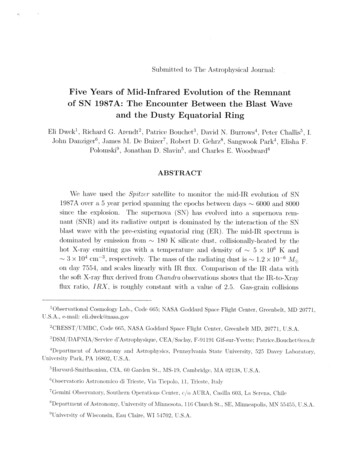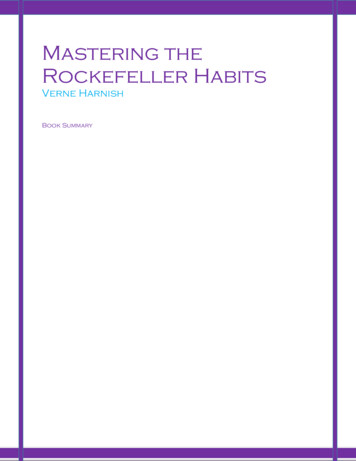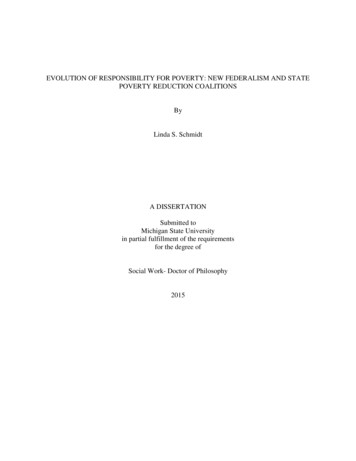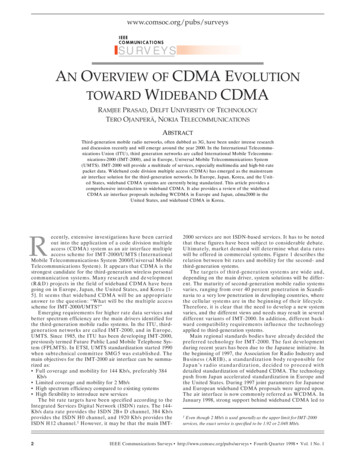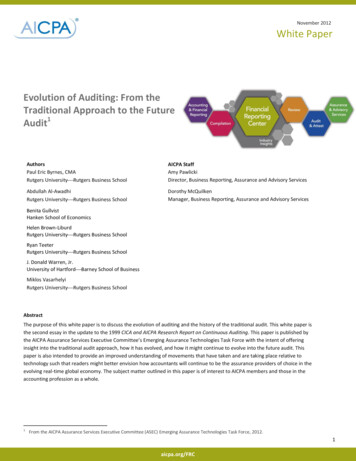
Transcription
ties that bind:the evolution of educationfor professional nursing inCanada from the 17th to the21st Century1
This Project was undertaken by CASN National Office Staff to mark theoccasion of the 70th Anniversary of the Canadian Association of Schools ofNursing.Authors: Cynthia Baker, RN, PhD, Elise Guest, MA, Leah Jorgenson, MA, Kristine Crosby, MA,and Joni Boyd, RN, MEd Canadian Association of Schools of Nursing, 2012Cover photo Reference: [Photograph of lecturing to student nurses in the large theatre, The Hospital for Sick Children, Toronto, Ont.] G. Milne, National FilmBoard of Canada. Still Photography Division [graphic material] (R1196-14-7-E), Library and Archives Canada, Ottawa, Ontario.2
PrefaceDear Reader,The Canadian Association of Schools of Nursing is pleased to provide you with acopy of this booklet on the history of nursing education in Canada. Written to celebratethe organization's 70th Anniversary, it provides a synthesis of information based onarchival CASN documents and secondary sources.This booklet takes you through the historic, political and social events thatinfluenced the health care system and education of Registered Nurses in Canada thatled to the development and evolution of the Canadian Association of Schools ofNursing. It highlights the influence of gender, religion, class and ethnicity on nursingeducation in Canada. Finally, it honours the significant contributions that nurseeducators and nursing students have made to the health of the citizens of this countryover the years.On behalf of the CASN Board of Directors, I sincerely hope that you will enjoy andtreasure this brief account of our past.Sincerely yours,Clémence DallaireCASN PresidentNovember, 20121
IntroductionAs part of the activities marking its 70th Anniversary, the Canadian Association of Schools of Nurses(CASN) has developed a history of nursing education in Canada. This document honours the significantcontributions nurse educators and nursing students have made to the health of the citizens of this countrybeginning in the very early settlements of Québec in the 17th century. Based on secondary sources andarchival CASN documents, our story starts with the hospitallers, the nursing religious orders that arrived inQuébec in 1639, and continues through four centuries, concluding with the history of CASN since its creationin 1942. The evolution of nursing education in Canada is discussed within the broader context of a changingpolitical landscape and health care system.The history of nursing education in Canada is a story laced with the effects of gender, religion, class,and ethnicity; it is also a story about silencing and dismissive non-recognition. What emerges, however, isthe powerful impact that nursing education has had on the quality of health care from the inception of thiscountry. The overall direction of the evolution of nursing education in Canada is one of significant progress.This progress, however, has been fraught with major obstacles that have occurred with cyclical regularity.The emerging themes include the need for educated nurses to improve patient outcomes overridingcompeting forces blocking their education. New or reformed model of nursing education were created,followed by the subversion or erosion of this by external forces, and a subsequent decline in standards.Then, the need for better-educated nurses to ensure adequate patient outcomes re-emerges.1
Nursing Education from the 16th to the 21st CenturyReligious BeginningsWhen asked to consider the birth of health care in Canada, Canadians often think of SaskatchewanPremier Tommy Douglas, and the efforts of his provincial Cooperative Commonwealth Federationgovernment of the 1960s. Canada’s current national health care system undoubtedly arose from thismovement in the West of Canada, which resulted in the Canadian federal government legislating the MedicalCare Act in 1967 and providing public insurance for physician services (Fierlbeck, 2011). Our health caresystem, however, has its roots in an earlier network of health care services that were founded andadministered by trained nurses.To understand the beginnings of health care in Canada, one should look first to Marie Rollet Hubou. Thewife of Louis Hébert, a surgeon/apothecary, she came to the newly founded colony of New France in 1617.When Hébert died in January 1627, Marie remained in Québec and remarried. She then began visiting andcaring for her sick neighbours using knowledge that she had acquired from her first husband (Gibbon, 1947).The need for nursing services in the settlement was enormous.Trained nurses, members of female religious nursing orders, soon began arriving from France.Between 1632 and 1683, the annual publication of Jesuit Relations, a series providing missionary reports onthe new world, inspired courtiers and philanthropists in France, motivating the migration of nursing orders tothe colonies to care for the settlers (Gibbon, 1947). These nurses played a critical role in supplementing atradition started by Marie Rollet, of untrained nurses providing care in the community, with new institutionswhere the sick could acquire care. The Order of Nursing Sisters from Dieppe, the first trained nurses to cometo this country, arrived in 1639 and founded Québec’s Hôtel-Dieu in the same year. Three years later, JeanneMance, a lay nurse from France established the Montréal Hotel-Dieu. These institutions proved to beprecursors of a widespread network of Catholic hospitals across Canada founded and run by female religiousnursing orders (Violette, 2005).Hôtel-Dieu institutions, were religious houses, run by religious orders. Religious orders providedhealth care based on the Christian virtue of charity; their members received educational training as nurses[Photograph of Hotel Dieu, Quebec.] Peter Winkworth Collection of Canadiana (Acc. No. R9266-97), Library and Archives Canada, Ottawa,Ontario.2
within the order, which also employed physicians to provide medical treatments (Violette, 2005). That theysurvived and grew in the succeeding centuries is something of an historical anomaly. North America in the17th and 18th centuries can only be characterized as colonial; the English established a foot-hold with theThirteen American Colonies (from New York to Georgia), and the French settled along what is now the St.Lawrence Seaway. A contested situation, it ended with a defeat of the French, who were forced to sign overtheir colony in North America to England as part of the 1763 peace settlement. As a condition of the treaty,England guaranteed the French colonists the right to retain their religion, which was achieved with theQuébec Act (1774). For the first time in a British holding, the Catholic Church was allowed to retain itsauthority, and Catholic religious orders were free to deliver services to their communities. Pauline Paul, anurse historian who has documented the significant role nursing sisters played in developing health care inWestern Canada, notes that the 1774 Act not only protected an important piece of French-Canadian culture,but secured a major component of the emerging health care services in the early history of this country(Paul, 2005).The Grey Nuns who first arrived in Québec in 1737 were among the Orders to benefit from thislegislated protection of religion. Under the direction of Marie-Marguérite d'Youville, they founded a poorhouse, and a year later took over the management of Montréal’s Hôpital Général (Hanrahan & Pedersen,n.d.). The number of institutions established and run by the Grey Nuns continued to grow throughout the19th century both in and outside of Québec. In 1844, Bishop Provencher recruited a group of Grey Nuns tovoyage to Western Canada. They arrived by canoe bringing much-needed health care to the frontiercommunity of Red River (Paul, 2005). The following year, the Grey Nuns established a hospital in Bytown(now Ottawa) (Gibbon, 1947). Continuing in their tradition of providing care to communities in need, theOrder of Grey Nuns returned to the Red River Colony where they established another hospital in 1855,followed by one in Lac Ste-Anne (near Fort Edmonton) in 1859.[Photograh of L'Hôtel Dieu 1877. Salle des femmes malades.] (C-022763), Library and Archives Canada, Ottawa, Ontario.3
Rise of the Lay HospitalWhile the Grey Nuns were taking advantage of the religious freedoms granted under the Québec Actin the 19th century to build health care across the country, lay hospitals were being established for the poor,soldiers, sailors, and new immigrants (McPherson, 2005). The Montréal General Hospital opened in 1821(and should not be confused with the earlier hospital run by the Grey Nuns of the same name); the TorontoGeneral Hospital had its roots in a military hospital set up in 1812 which led to the establishment of the YorkGeneral Hospital in 1829; in Halifax, the Victoria General was founded in 1844 and began operations in 1867;Hamilton received a grant for a General Hospital from the Government of Upper Canada in 1850 and locatedit into a three-story brick building in 1855; the Protestants in Ottawa supported the establishment of theCounty of Carleton General Protestant Hospital (later to become the Ottawa Civic) in 1852; Winnipeg, thefirst in the Prairies to establish a lay hospital, opened the Public General Hospital in 1872 (Gibbon, 1947).This hospital movement continued to grow and by 1929 there were 954 hospitals in Canada: Of these, therewere 481 public general hospitals, 42 mental hospitals, 31 tuberculosis sanitoria, 33 for incurables, and 269private hospitals (Canadian Museum of Civilization, 2010). In marked contrast with the hospitals founded bythe religious orders, lay hospitals were to be staffed by student nurses and run by physicians.Initially, epidemics played an important role in the establishment of lay hospitals. As migrants floodedinto Canadian ports, many arrived with contagious diseases such as typhoid and cholera. In order to protectthe resident population, public officials organized quarantine hospitals, such as the Immigrant Hospital inQuébec City (f. 1824) and the Marine and Immigrant Hospital, also in Québec City (f. 1830) (Gibbon, 1947).The key forces driving the growth of lay hospitals in the later part of the century, however, wereadvancements in medical science and the professionalization of physicians (Violette, 2005).Despite efforts to look after the sick in the first lay hospitals, untrained attendants provided nursingcare. As a result, the level of care was low and the conditions were rank. Those immigrants arriving withcontagious diseases often saw no more of their new country than their journey from the ships they came onto the hospital where they died. As the 19th century progressed, medical treatment in hospitals became saferand more effective with the gradual introduction of asepsis and anesthetics from 1848 onward. By the 1880shospitals had begun to serve the middle and upper classes laying the foundation for the two-tiered, hospitalbased system of care that characterized the health care system until the introduction of National health carein 1969 (Canadian Museum of Civilization, 2010).Secularization of Nursing EducationThe nursing religious orders had a well-developed system of nursing education (Violette, 2005) but itwas only for religious recruits in the order. Lay hospitals run by physicians introduced a new secular model ofeducation for lay nurses. In 1874, Dr. Theophilus Mack initiated this, establishing the first hospital trainingschool in Canada in St. Catherines Ontario, with the assistance of two nurses trained under FlorenceNightingale. Convinced that respectable, young women educated to be nurses were needed to improveoutcomes in the public hospitals and alter the public’s deep-seated prejudice against going to them, he wrotein his first annual report in 1875: “all the most brilliant achievements of modern surgery are dependent to agreat extent upon careful and intelligent nursing. Incompetency on the part of a nurse renders nugatory thebest efforts of the doctor in the most critical moments, and has frequently resulted in loss of life” (cited inGibbon, 1947, p. 145). McPherson (1996), an historian who has studied the history of nursing in Canada,described this as a reflection of a much wider international movement involving “the ascent of medicalcontrol”, and “the evolution of hospitals from charitable and custodial institutions to socially respectable andtherapeutic ones” (p. 6), both of which required a more highly skilled nursing workforce.The secular hospital training model introduced in Canada by Dr. Mack and the religious training modelof the nursing sisters had their roots in Western Europe. Historically, European religious orders provided4
[Photograph of staff and first graduating class of the Mack Training School for Nurses, 1878.] Canadian Nurse Association (MIKAN 3604067), Library and Archives Canada, Ottawa, Ontario.nursing services and nursing education, and this continued following the reformation in Catholic countriessuch as France. Thus, the first nursing nuns (hospitallers) in Québec brought this tradition with them. Prayerand religious rituals were always an important component of their education as nurses, but it involved more,including pharmacology, hygiene, wound dressing, and making and administering medications. Thesenursing nuns learned first by observation, then through supervised caregiving at the bedside, and finally byan apprenticeship with a pharmacist (Violette, 2005). Medical treatment in their hospitals was provided byphysicians who “had authority over medical decisions but carried out their work under the administrativesupervision of the head hospitaller” (Violette, 2005, p. 61).Following the Reformation in Europe, monasteries and convents declined in Protestant Europeancountries, and their hospitals closed. Indeed, 1500 to 1860 A.D. has been called the “dark period of nursing”for this reason (Jamieson, Sewall & Suhrie, 1968, p.148; Mellish, 1984, p. 54). Nothing was done to replacethe nursing services the nuns and monks had delivered, nor the nursing knowledge they had developed, andthe lay hospitals of the period were unsanitary, overcrowded, and a source for epidemic outbreaks (Mellish,1984; Jamieson, Sewall & Subrie, 1968). It was in this context that Florence Nightingale established hercelebrated model of nursing education, outside the control of a religious group, thus beginning thesecularization of nursing education (Jamieson, Sewall, & Suhrie, 1969).Interestingly, the two nursing traditions brought to Canada from Europe, intersected with one anotherthrough Nightingale herself. Persistent in her pursuit of a nursing career, Nightingale looked foropportunities that would allow her to learn about nursing. As a result, she studied in Rome with acommunity of nuns, in Alexandria with the Sisters of Charity of St. Vincent de Paul, and in Greece at a school5
and orphanage run by American missionaries (McPherson, 2005). Sioban Nelson, a nurse historian whostudied nursing in religious orders internationally in the nineteenth century, indicates that Nightingaleborrowed from Irish Catholic orders in the Crimea (Nelson, 2001). Thus, her perspectives on nursing andnursing education were influenced by the knowledge the religious orders had developed. In describing whatshe considered to be vital in a nurses’ education Nightingale notes: what strikes one most with many women, who call themselves nurses, is that they have notlearnt this A B C of a nurse’s education. The A of a nurse ought to be to know what a sick humanbeing is. The B, to know how to behave to a sick human being. The C, to know that her patient isa sick human being and not an animal” (Nightingale, 1860, p.128).In her Notes on Nursing (Nightingale, 1860) we see the “B” of nursing education:It (nursing) has been limited to signify little more than the administration of medicines and theapplication of poultices. It ought to signify the proper use of fresh air, light, warmth, cleanliness,quiet, and the proper choosing and giving of diet – all at the least expense of vital power to thepatient (p.15).As her popularity grew during her service in the Crimea, supporters in England set up the “NightingaleFund” in 1855 in recognition of her work (McPherson, 2005). The Fund amounted to 50,000 (Jamieson, E.,Sewall, M. & Suhrie, E., 1968, p.149), and was used to establish a nursing school at St. Thomas’s Hospital inLondon (Bates, Dodd, & Rousseau, 2005). There were three main goals of the Nightingale School: 1) to train‘matrons’ who could organize hospitals and train others; 2) to train hospital nurses who could supervise theuntrained nurses; and 3) to train district nurses to care for the sick poor in the community.[Photograph of Florence Ward (St Thomas' Hospital).] (Object number 0060), Florence Nightingale Museum, London, United Kingdom.6
Nightingale had a strict code of conduct in her school that served to increase the respectability ofnurses, and as a result, the school soon began to attract women from the upper- and middle- classes(Mellish, 1984). Dr. Mack’s program of education incorporated this ethic for the same reasons. Strictregulations were set out in the by-laws, the first of which reads:The nurses in the daily discharge of their duties must observe the strictest secrecy, and carefully avoid‘gossip’, their demeanour should be kind and respectful on all occasions, and when on duty at privatehouses, they are expected, in addition to taking the completecharge of their patients, to avoid giving unnecessary trouble, to wait upon themselves,and to pay the closest attention to the preparation of ailments for the sick, as well as tocheerfully assist in many matters not strictly within their duty – to faithfully carry out thephysician’s directions, and in the event of emergencies, to report any instance when theexecution of his orders have been exceeded or omitted. To evince no bias to anyfavourite medical practitioner. To attend scrupulously to the special duties to the patientwith the gentleness and exactitude taught by their superiors, and never to interfere with orcriticize treatment (as cited in Gibbon, 1947, p144).The new hospital training school model spread rapidly and dominated nursing education for almost acentury. Dr. Mack stressed the educational component of the model when setting it up, stating in his firstannual report on the school in 1875 that:E]very possible opportunity is seized to impart instruction of a practical nature in theart of nursing, while teaching will be given in chemistry, sanitary science, popularphysiology and anatomy, hygiene and all such branches of the healing art as a nurseought to be familiarized with (cited in Gibbon, 1947, p. 145).The model, however, was an apprenticeship one, and nursing students quickly became the workforceof the rapidly burgeoning system of hospitals and hospital-based health care in Canada. In 1887 theWinnipeg General School of Nursing was founded, followed by Halifax’s Victoria General School of Nursing in1890 and St. Michael’s Hospital School in 1892 in Toronto. From there, hospital schools grew exponentiallyand by 1909 there were 70 hospital schools, and over 200 by the 1920’s (McPherson, 2005).While the initial impetus for educating nurses in secular hospital training schools was to improvepatient outcomes, the economic benefits quickly superseded the original purpose. Except for a very smallnumber of supervisors and instructors, the students provided the nursing services in hospitals. From theirinception, hospital training schools kept this young, female workforce of nursing students under tight control,and in contrast with the hospitallers of the religious orders, they and their instructors stood in very much of asubservient position to the increasingly dominant physicians.Hospital schools generally followed a familiar
The history of nursing education in anada is a story laced with the effects of gender, religion, class, and ethnicity; it is also a story about silencing and dismissive non-recognition. What emerges, however, is the powerful impact that nursing education has had on the quality File Size: 1MBPage Count: 36People also search forevolution of canadian nursing informaticson all frontiers, canadian nursingevolution of nursing informaticsevolution of health informaticsinformatics and technology in nursing
